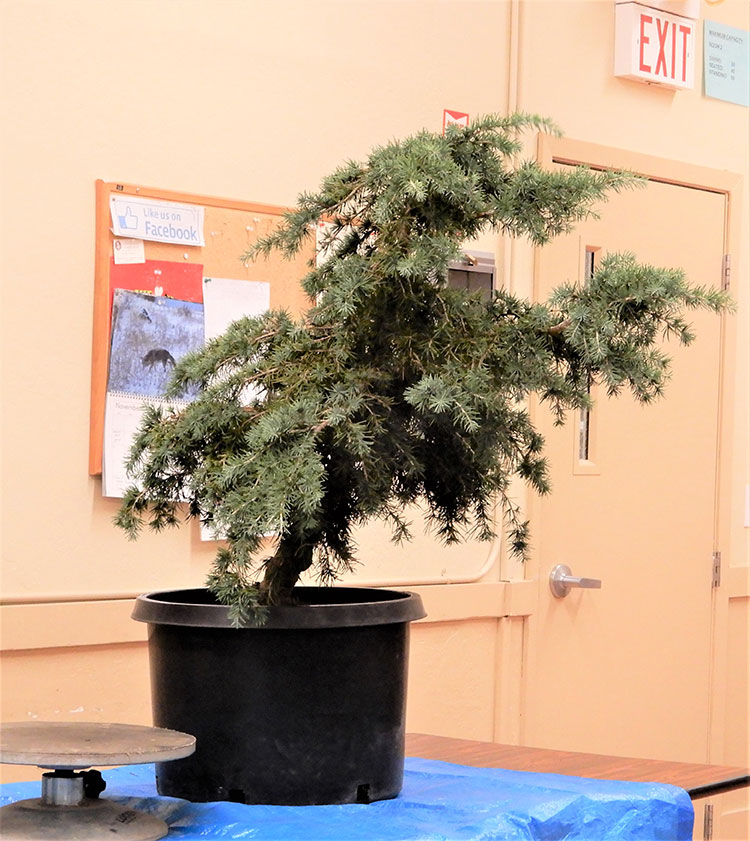Professional aesthetic pruner, long-time bonsai enthusiast, and avid bonsai experimenter Randall Lee brought several species of cedar with him in November to demonstrate how to raise and style the variety. The last time we saw Randall was in January of 2018 when he created a dramatic forest of elms on a slab.
In addition to the demonstration tree, Randall also brought five other cedars, including a Sapphire Nymph (a dwarf variety related to the Blue variety, with stunningly short needles) and a subspecies of Lebanon cedar. He referred to these as he talked briefly about the different growth styles of the different varieties of cedar.

The demonstration tree was a Deodar cedar. As part of sizing up its potential, Randall told us some of the tree’s history. It was collected from a yard that was being redesigned during the spring of this year. It was not aggressively root pruned at that time, but Randall cautioned that the eventual winner of the tree should wait at least a year to repot the tree anyway. It was only in the ground for three years before it was collected, so it doesn’t have an overly robust root ball. It originally had more of a slant and Randall found clear evidence that it was propagated via a root graft 15 to 20 years ago. Although such grafts can leave ugly scars on most trees, thankfully Deodar cedars bark over readily to cover such things, so much so in this case that Randall was barely able to identify the graft point.
Randall began work on the Deodar cedar by removing some obvious unwanted and small branches before getting the audience to help choose the front. As that was being discussed, he got a few gasps as he casually removed another, rather large branch–one that was too large for how high on the trunk it was, he was moved to explain.

Randall pointed out that he was leaving a lot of branch stumps. He was doing this, he explained, because the bark on this variety does not callous over wounds very quickly or very well, so he didn’t want to leave the tree with a trunk that would look like Swiss cheese for months or even years to come. He said that the winner can cut the stumps off slowly over time, but Randall’s inclination was to simply jiin them. He stripped a couple of the stumps of their bark to demonstrate how that would look.
Getting back to the topic of choosing the front of the tree, Randall concluded that there were two potential options. The one with more nebari would be ideal, but would require tilting the tree to get the apex aiming back toward the viewer, one of the most basic features of a good bonsai.
There was a question from the audience regarding cones growing on bonsai cedars. Randall said that once you get a cone, typically on a little “peg” off a branch, that little growth peg will never develop further with or without the cone, so you might as well remove it to conserve the tree’s energy.
As he began to wire the tree, Randall acknowledged that much of what he wired at that time would most likely be removed as the tree matured, but he saw no reason to avoid making the tree look nicer, and is generally the type of person who likes to mess around with a tree as much as possible at every stage. And finally, as if to demonstrate that nobody is perfect at wiring, Randall admitted that one of the branches he wired cracked while he was bending it. But what makes him an expert is that he made sure to leave some extra branches during the pruning stage. He said he always leaves extra branches on developing cedars because they can be quite brittle.

The tree was won by one of our newer members, with a remarkably similar name to Randall’s: Randy Lee Cupp. Congratulations and enjoy the tree, Randy! Be sure to bring the tree back in the future to show us its progress.
– David Eichhorn
Photos courtesy of George Haas




